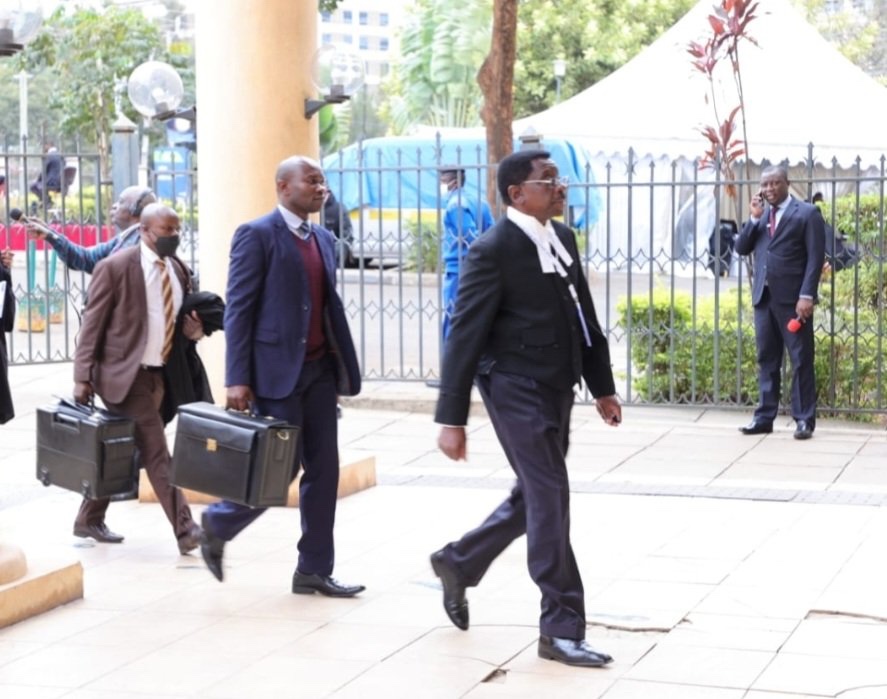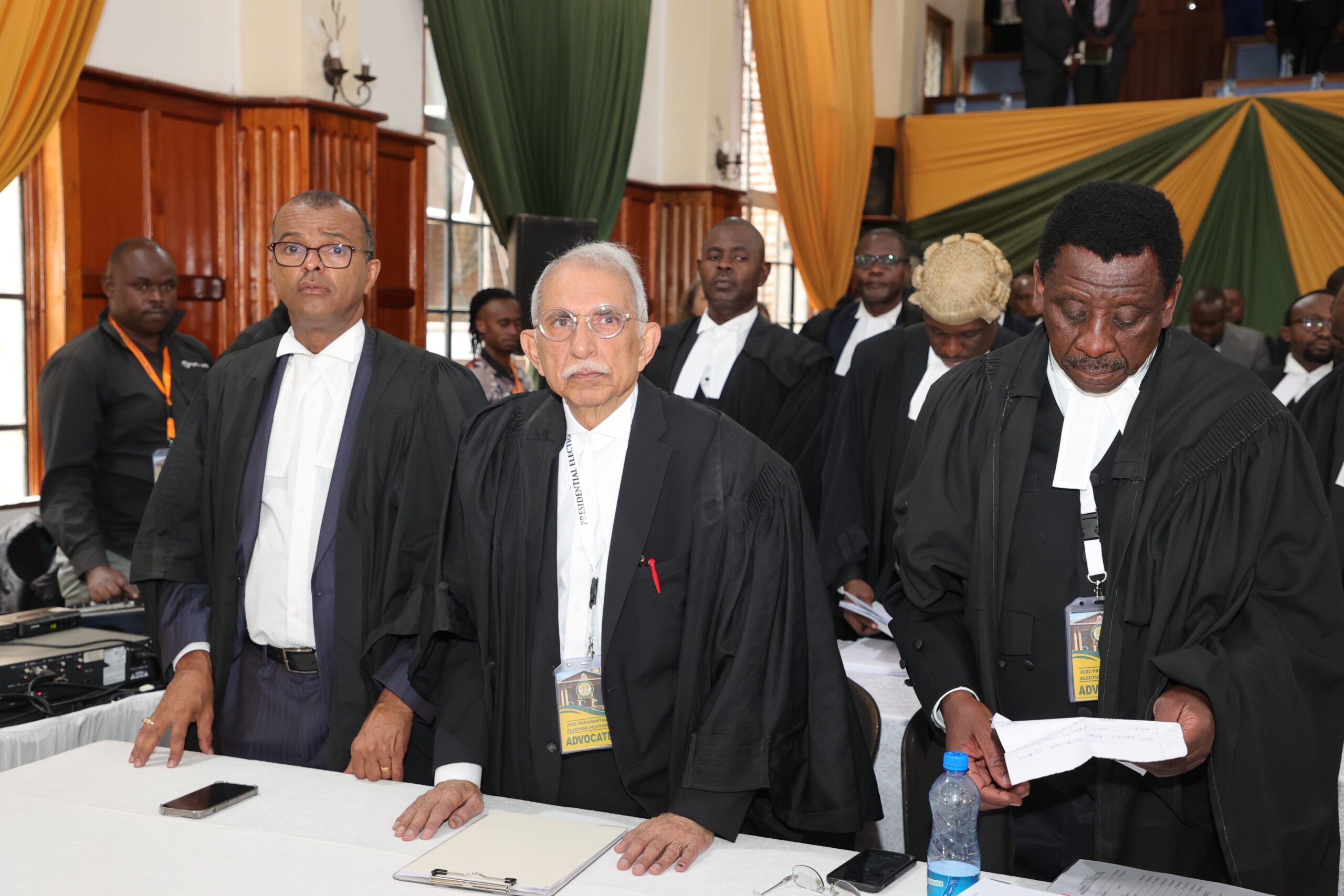Doubts about actual voter turnout and claims Mr Raila Odinga was robbed votes to top up his rival’s tally featured in submissions as hearings in the presidential election petition challenging declaration of Dr William Ruto as President-elect opened yesterday.
Mr Odinga’s team laid out what it said was a plan to deduct his votes in some areas, take out 140,000 ballots from the total turnout to give Dr Ruto a majority win and exclude 27 constituencies from the final results. It alleged that a total of 4,463 votes were deducted from Mr Odinga and added to Dr Ruto.
The lawyers also argued that the postponement of elections in eight electoral areas – including governor polls in Kakamega and Mombasa – was meant to suppress voter turnout in what they said were strongholds of the Azimio la Umoja One Kenya Coalition boss.
Hatched and executed by Chebukati
The pro-Ruto scheme, Mr Odinga’s team held, was hatched and executed by Independent Electoral and Boundaries Commission (IEBC) Chairperson Wafula Chebukati, supported by CEO Marjan Hussein Marjan and two commissioners – Abdi Guliye and Boya Molu.
The IEBC, Mr Odinga’s legal team argued, did not conduct a credible, free and fair poll as per the constitution.
They said Mr Chebukati’s faction of the commission allegedly bulldozed over the majority of commissioners, and excluded four of them – Vice-Chairperson Juliana Cherera and commissioners Irene Masit, Francis Wanderi and Justus Nyang’aya – to avoid interference with plans to rob Mr Odinga of his victory.
The former Prime Minister has challenged the presidential election results for the third consecutive election cycle, and has asked the Supreme Court to either order a recount and declare him winner if the votes support his prayer, or to nullify the August 9 polls and order for a fresh one.
Criminal sanctions against Chebukati
His 2022 petition could have grave consequences if granted entirely, as he has also called for criminal sanctions against Mr Chebukati, who is at the tail end of his term at the helm of the elections commission. The IEBC boss’s six-year tenure ends on January 20 next year.

Siaya Governor James Orengo, who is leading Mr Odinga’s legal team, told the court that neither the process nor figures declared by IEBC can be trusted owing to a scheme he argued was plotted by Mr Chebukati to ensure that Dr Ruto emerged winner of the heated presidential race.
50 percent plus one
Mr Orengo held that even going by the results Mr Chebukati declared on August 15, Dr Ruto could not have garnered more than half of the valid votes cast as required by the constitution.
While making reference to an affidavit sworn by statistician Edgar Otumba, Mr Orengo held that using the disputed IEBC figures, Dr Ruto got 49.9 per cent but was still declared president-elect.
Mr Otumba was one of the experts that the then Justice David Maraga-led Supreme Court relied on in 2017 to nullify the results of the presidential elections.
Glaring discrepancies
Mr Odinga’s team said that there were glaring discrepancies between figures relayed by voter identification kits and those entered into the results transmission forms.
The discrepancies, Mr Orengo said, show that more than 140,000 votes disappeared from the ballot tally and would have had an impact on the results of the election.
He was insistent that internal wrangles within the IEBC, which have seen four commissioners disown the election results, are also an indication that the agency was not capable of conducting an election, hence the accuracy of its results are doubtful.
“We are talking about an electoral commission that is dysfunctional and cannot be able to carry out an election. That is a matter that this court should not disregard,” Mr Orengo said.
Mr Odinga’s team has also asked the court to consider that there were two groups of people with unauthorised access to IEBC systems, who allegedly manipulated results and transmission forms.
Desired outcome
Senior Counsel Philip Murgor argued that the first group included Mr Chebukati’s personal assistant Dickson Kwanusu, and its role was to curate Form 34C – the final results transmission form used to declare the presidential election winner – to ensure the document mirrored the IEBC chairperson’s desired outcome.
Mr Kwanusu allegedly accessed IEBC systems more than 1,000 times to edit Form 34C.
Another individual identified as Abdidahir Abdi, who did not have authority to access IEBC systems, allegedly edited more than 600 forms 34A.
Primary document
Form 34A is the primary results transmission document, as it indicates the votes tallied at the polling station. A 2017 Court of Appeal judgment held that results from polling stations are final and can only be altered with orders from the Supreme Court.
The second group of people with unauthorised access worked from outside Bomas, and some outside the country.
“The IEBC elections technology was so inherently corrupted, manipulated and tainted that results declared cannot be said to represent the will of the people,” he argued.
Three Venezuelans
Mr Murgor said that the three Venezuelan nationals arrested in July with sensitive election materials may have also accessed the IEBC system to manipulate results.
The three Venezuelans – Salvador Javier Sosa Suarez, Jose Grecorio Camarigo Castellanos and Joel Gustavo Rodriguez Garcia – had super administrator access to the polls body’s systems, Mr Murgor added.
“You will find that an analysis of the logs shows several generations of Form 34C. You see several downloads of forms 34A in CSV format, which is an editable format. As of August 12, 2022, a Form 34C had already been generated. Results were barely in. What was the business of anyone in that system generating a Form 34C? This election was controlled from everywhere except the IEBC,” Mr Murgor said.
Results from 27 constituencies
Mr Odinga’s team also holds that the results Mr Chebukati announced on August 15 excluded results from 27 constituencies, which would have significantly changed the election results.
The former Prime Minister argues that Mr Chebukati declared a winner when results from 27 constituencies had not been verified and tallied as required by law.
Mr Paul Mwangi, one of Mr Odinga’s counsels, submitted that Mr Chebukati and Dr Ruto have contradicted each other on whether results from the 27 constituencies were read.
Mr Mwangi said Dr Ruto insists in his affidavits that the results were read, while the IEBC says that violence on the floor of the National Tallying Centre at Bomas of Kenya prevented the reading of the results.
“One of the most glaring things is the issue of the 27 constituencies. Ruto knows the importance of this because he purports in his affidavit that those results were read. The affidavits of Mr Chebukati and Prof Guliye say those results were not verified or read.
“The power given to the chairperson of the IEBC to announce results does not give him power to decide what that result will be,” Mr Mwangi submitted.
Manipulation
On the allegation that Mr Odinga’s votes would be deducted and added onto Dr Ruto’s in some polling stations, Azimio’s team sampled polling stations in Bomet, Kakamega, Kiambu, Nairobi and Baringo counties to prove the manipulation.
The vote swap scheme, Mr Odinga’s team argued, saw Dr Ruto benefit from over 4,000 votes.
Julie Soweto asked the court to note that as per IEBC’s disputed figures, Dr Ruto avoided a run-off by only 69,000 votes. She said that the vote swap scheme is demonstrated in an affidavit filed by Ms Celestine Anyango, one of the experts that Mr Odinga’s legal team is relying on.
“For example in Chepalungu polling station 1/1, Mr Odinga had 61 votes in the form at the polling station. In the form uploaded on the IEBC portal, Mr Odinga had 1 vote and Dr Ruto had 109 votes. In the IEBC portal, he has 169 vote. The same continues in all the 41 polling stations we have sampled and annexed to the affidavit of Celestine Anyango,” Ms Soweto said.
Votes variance
She added that the wide margin between presidential votes cast compared to other elective positions also points to fraud.
The Odinga team said more than 33,000 ballots are unaccounted for through the votes variance.
Senior Counsel Pheroze Nowrojee argued that Mr Chebukati lied about the law giving him authority to postpone gubernatorial elections in the manner that he did the Kakamega and Mombasa polls.
Mr Nowrojee held that the law does not envision postponement on account of procurement blunders such as what happened with the IEBC.
Blunders intentional
One of the commissioners opposed to Mr Chebukati, Ms Masit, has claimed that the procurement blunders were intentional as the IEBC chairperson wanted to suppress voters in Mr Odinga’s strongholds.
Ms Masit says in her affidavit that Mr Chebukati deliberately failed to send inspection teams to Greece to confirm that the process was going on smoothly.
Mr Nowrojee said that Mr Chebukati did not involve other commissioners in any crucial processes, including postponement of some elections. He held that whichever way judges rule, Mr Chebukati should not be allowed to head the electoral agency.
“Whatever the outcome, we cannot have the person who is doing false affidavits to be the chair of the IEBC,” Mr Nowrojee submitted.
Today, the court will hear the responses by Dr Ruto, Mr Chebukati and the IEBC.
There's no story that cannot be told. We cover the stories that others don't want to be told, we bring you all the news you need. If you have tips, exposes or any story you need to be told bluntly and all queries write to us [email protected] also find us on Telegram

